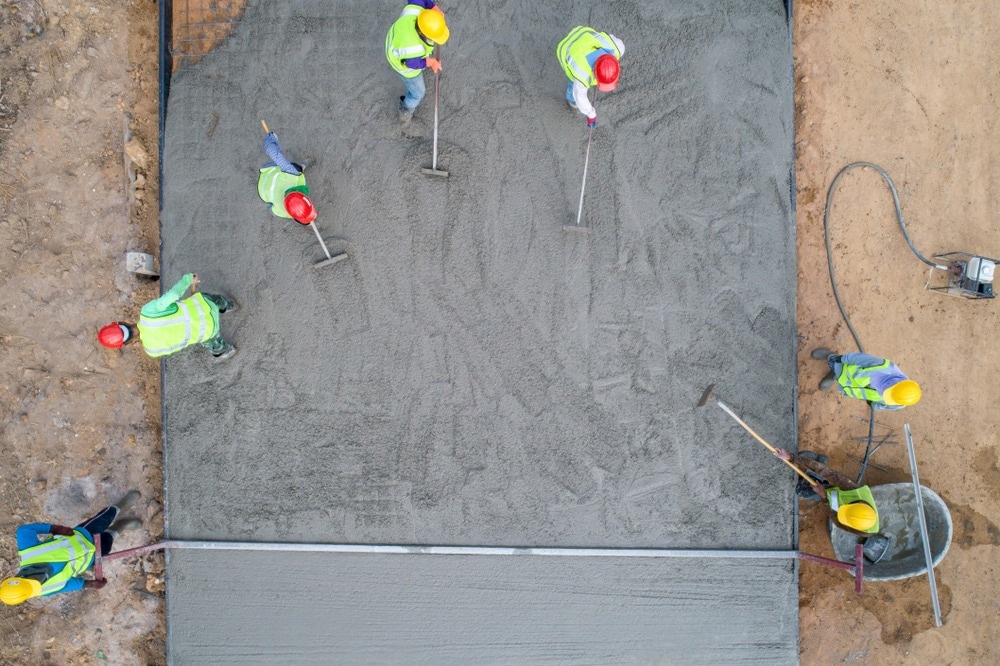Rheological concepts and methods used in concrete incorporate the deformation of hardened cement paste, the handling and placement of newly mixed concrete, and the characteristics of its component elements, particularly concrete and slurries.

Image Credit: Bannafarsai_Stock/Shutterstock.com
What is Rheology?
Rheology is the study of material flow and deformation. It is the science of materials whose flow characteristics are more intricate than those of basic fluids such as liquids and gases. It is able to determine the relationship between stress-strain, strain rate, and strain time.
Concept of Rheology in Concrete
The theory of rheology may be used to investigate concrete mixture deformation, the characteristics of cement paste, and the processing and placement of concrete mixtures in fresh conditions.
This is why rheology is used in all phases of the construction process, from fresh to hardened concrete.
A wide range of elements influence the rheology of concrete. Admixtures have a direct impact on concrete at the microscopic level, and this influence propagates throughout the scales to the macro level.
Rheology on paste may therefore yield accurate relative characteristics at the concrete level for varied admixed concrete, although the absolute rheological characteristics of concrete cannot be directly obtained from these studies. Recent years have seen major advances in our knowledge of concrete rheology, both practically and conceptually.
Rheology is used to understand the concrete's consistency, behavior, setting time, and workability. Workability demonstrates the essential stability, mobility, and compatibility characteristics for determining the appropriateness of any concrete mixture.
For the purpose of determining the rheological characteristics of fresh concrete, the aforementioned parameters are defined on the basis of the forces associated with the transfer of mechanical stresses to the concrete. Fresh concrete is exposed to normal and shearing stresses during its handling and placement.
The rheology concept of hardened concrete exemplifies the mechanical behavior of an ideal viscous, elastic, and plastic material. Creep is the steady rise in strain over time without an increase in stress. Consequently, creep is defined as the rise in strain under persistent tension.
Under prolonged stress over time, its gel, the water-adsorbed layer, the water retained in the gel pores, and the capillary holes all give, flow, and realign. This phenomenon is also known as concrete creep. It is important to remember that concrete might display thixotropic behavior depending on the pace at which the structure is built up.
The variables of mobility, stability and compactability are described in terms of forces or stresses acting on the concrete mix. Those are all created by mechanical stresses being transmitted inside it. The procedure of compaction includes expelling air bubbles from the concrete mixture and rearranging the particles to produce a dense mass.
Stability and Mobility of Concrete
Stability is the characteristic of a concrete mixture in which the aggregate particles are uniformly dispersed and resemble a random sample. This attribute is shown throughout its transportation, placing, and compaction. There are now two criteria that determine the mixture's stability: segregation and bleeding.
Mobility is the capacity of the concrete fluid mixture to flow. This mobility results from the activity of mechanical tensions, commonly known as moment transmission. There are several variables that hinder the flow of concrete, including cohesive forces, viscous forces, and frictional forces.
New Advancements
Manufactured sand is gaining significant attention in concrete, and it is vital to forecast the rheology of these suspensions depending on their composition. The focus of research from Norway in the journal Construction and Building Materials is on cement pastes using produced sand and silica fumes.
Ten alternative models were tested for their capacity to predict the rheological behavior of cement pastes including manufactured sand and silica fume. Overall, the MLP prototype outperformed all other models for the matrices tested, indicating how artificial neural network forecasts are a potential route to explore in cement paste rheology.
A Chinese study in the journal Materials shows the impact of nanoparticles on cementitious materials' rheology, mechanical characteristics, 3D printing, and microstructural effectiveness. Rheology and slump can be used to measure the flow parameters of new cementitious composites.
Hardened characteristics are shown by mechanical qualities such as flexural, compressive, and split tensile strength. Shrinkage, porous structure, and permeability testing are required to determine a nanomaterial's durability in concrete.
Research and References
Song, H., and Li, X. (2021). An Overview on the Rheology, Mechanical Properties, Durability, 3D Printing, and Microstructural Performance of Nanomaterials in Cementitious Composites. Materials. https://doi.org/10.3390/ma14112950
Skare, E., et al. (2022). Rheology modelling of cement paste with manufactured sand and silica fume: Comparing suspension models with artificial neural network predictions. Construction and Building Materials. https://doi.org/10.1016/j.conbuildmat.2021.126114
Disclaimer: The views expressed here are those of the author expressed in their private capacity and do not necessarily represent the views of AZoM.com Limited T/A AZoNetwork the owner and operator of this website. This disclaimer forms part of the Terms and conditions of use of this website.